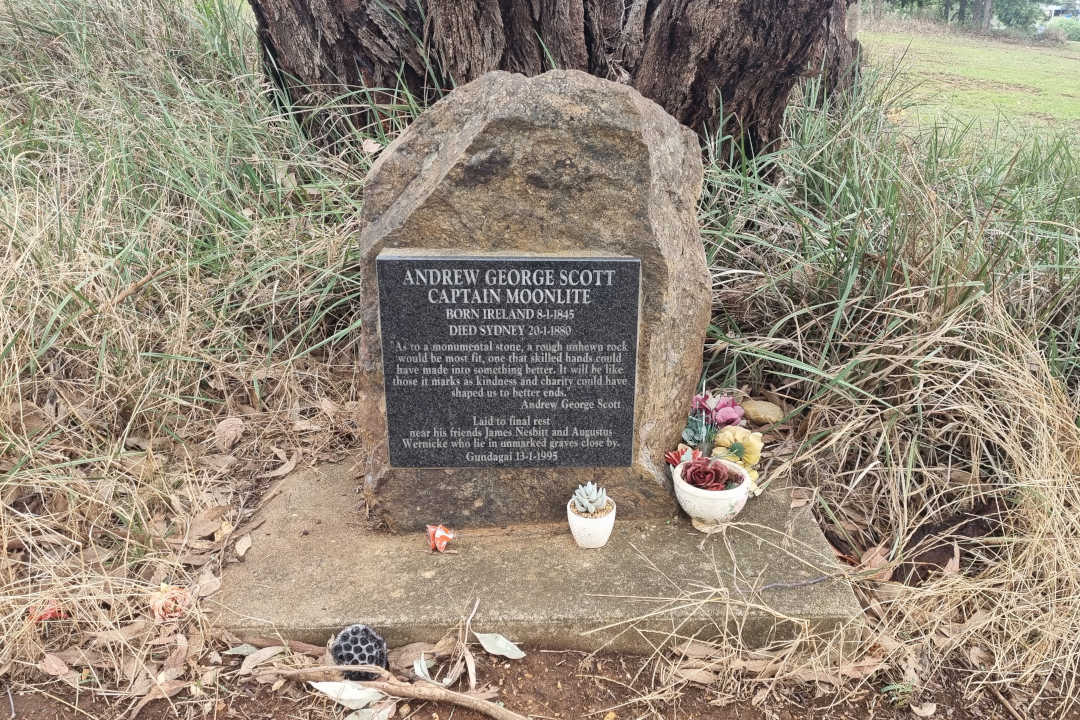Graves of Captain Moonlite and James Nesbitt listed on the State Heritage Register
The Gundagai graves of bushrangers Captain Moonlite (Andrew George Scott) and his devoted companion James Nesbitt have been listed on the State Heritage Register, offering a rare window into same-sex relationships in the 19th century that challenges typical stereotypes of Australian bushranger folklore.
Born in Ireland in 1845, Andrew George Scott was an educated man who despite his promising beginnings, turned to a life of crime. He committed his first serious offence in 1869, robbing a bank in Egerton, Victoria, wearing a flimsy mask and cloak.
After escaping to Sydney with the valuables from the bank’s safe, Captain Moonlite was later extradited to Victoria and incarcerated at Pentridge Prison where he met James Nesbitt.
Upon their release, the pair and four other young men moved to NSW where in 1879 they held up owners of Wantabadgery Station near Gundagai. During a dramatic shootout, Nesbitt was killed, with Captain Moonlite reportedly weeping as he cradled his companion’s body. The confrontation also killed two other bushrangers and a police officer.
Captain Moonlite was captured and sentenced to death. Awaiting execution at Sydney’s Darlinghurst Gaol, he penned more than 60 letters and 2 statements explaining his actions and professing his deep love for Nesbitt.
In a letter to Nesbitt’s mother, Captain Moonlite wrote:
'… his hopes were my hopes, his grave will be my resting place, and I trust I may be worthy to be with him where we shall all meet to part no more …'
Despite his plea, authorities did not send Captain Moonlite’s letters nor grant his final wish to be buried alongside Nesbitt in Gundagai. Instead, he was executed in January 1880 and laid to rest at Rookwood Cemetery.
More than a century later, Captain Moonlite’s letters were discovered, inspiring two Gundagai women in the early 1990s to campaign for his dying wish to be fulfilled. In January 1995, after 115 years separation, Captain Moonlite’s remains were exhumed from Rookwood and reinterred at North Gundagai Cemetery beneath a eucalyptus tree near Nesbitt’s burial site.
The listing of Captain Moonlite and James Nesbitt’s graves on the State Heritage Register further enriches the historical narrative of NSW. Their graves offer a rare window into same-sex relationships in an era when homosexuality was harshly suppressed by the state, challenging typical stereotypes of Australian bushrangers and providing one of the few publicly acknowledged same-sex relationships of the 19th century.
Quote attributable to the Minister for Heritage, Penny Sharpe:
'Captain Moonlite and James Nesbitt were outcasts even among outcasts, who might have lived very different lives in more contemporary times.
'This listing on the State Heritage Register reflects the desire to tell the diverse stories that reflect the rich history of NSW.'
Quote attributable to Duty MLC for Cootamundra, Stephen Lawrence:
'The protections afforded to the gravesites in North Gundagai Cemetery through listing on the NSW State Heritage Register ensure that this rare, one-of-a-kind site, and the life story it represents, are preserved.
'The letters written by Captain Moonlite to James Nesbitt give a rare insight into male same-sex relationships in the 19th century, and the listing shows respect for the many histories that shape NSW.'
